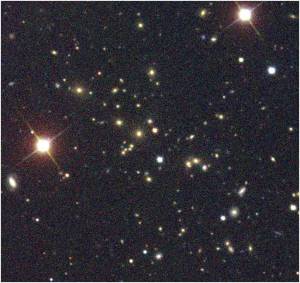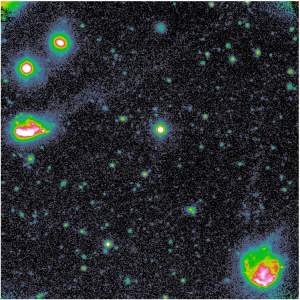 |
|
Fig. 1:
A rich cluster of galaxies that has been utilised for the present
study. The fluffy white-yellowish sources are galaxies belonging to
the cluster. All the rest are foreground and background sources,
including two bright stars. The intracluster light is not visible in
images like this, but combining several hundreds of them it can be
realiably measured, as explained in the text.
|
 |
 |
|
Fig. 2:
The creation of intergalactic stars caught in act in the nearby
cluster Abell 1367: two trails of gas and stars depart from the two
galaxies on the left and in the bottom right corner, probably due to a
tidal event occurred 50 million years ago. Courtesy of Peppo Gavazzi,
Universita' di Milano Bicocca
|
|  |
Galaxy clusters are large collections of tens to thousends of
galaxies, bound together by their mutual gravitational force and
extended over several millions of light years. In the optical light a
typical cluster of galaxies looks like the one in Fig. 1. Apparently
all the light that we see is coming from stars that belong to some
galaxy. However, since long time it has been recognized that the
intergalactic space is filled in with a diffuse starlight. In 1951
Fritz Zwicky reported that "vast and often very irregular swarms of
stars and other matter exist in the spaces between the conventional
spiral, elliptical and irregular galaxies" that make up one of the
largest known cluster in the constellation of Coma Berenices. Even
though this claim probably reflected more the profound conviction of
the Swiss astronomer rather than a real detection on the relatively
poor photographic material available at the time, the presence of
diffuse starlight has been confirmed by several observations in more
recent years. In fact, such observations are severely hampered by the
intrinsic low surface brightness of this intracluster light (ICL): the
luminous flux that we receive per unit area is roughly a factor 1,000
less than what we receive from normal galaxies and roughly the same
factor less than the glow of a "dark" night sky. Successful
detections have been obtained so far only for a small number of galaxy
clusters (less than 40) by means of very long exposures and
painstaking data reductions. Yet this is insufficient in order to
understand the origin and the role that the ICL has in the context of
cluster formation. A systematic description of the ICL is badly
needed.
At the Max-Planck-Institut fuer Astrophysik we have recently developed
a novel technique (see also  "The outermost
stellar haloes of galaxies") that allows us to combine
images of several hundreds of clusters, so that the resulting
sensitivity is strongly enhanced. Images are stacked after masking out
all the galaxies in the clusters and the contaminant sources which
happen to lie in the field of view (such as foreground stars and other
galaxies). In this way, we obtain an image where the diffuse ICL
alone emerges from an extremely flat and uniformly illuminated
background, and can be measured with unprecedented accuracy over four
orders of magnitude in surface brightness. Furthermore, what we
measure is the luminous emission averaged over a statistically
representative sample, thus making it possible to draw very general
conclusions. "The outermost
stellar haloes of galaxies") that allows us to combine
images of several hundreds of clusters, so that the resulting
sensitivity is strongly enhanced. Images are stacked after masking out
all the galaxies in the clusters and the contaminant sources which
happen to lie in the field of view (such as foreground stars and other
galaxies). In this way, we obtain an image where the diffuse ICL
alone emerges from an extremely flat and uniformly illuminated
background, and can be measured with unprecedented accuracy over four
orders of magnitude in surface brightness. Furthermore, what we
measure is the luminous emission averaged over a statistically
representative sample, thus making it possible to draw very general
conclusions.
The huge imaging database for this study has been provided by the
 Sloan Digital Sky Survey. From
roughly 1,500 square degrees in the sky, we have identified 683
clusters of galaxies between z=0.2 and z=0.3, whose images in three
different optical bands (i.e. wavelengths) have been stacked. Sloan Digital Sky Survey. From
roughly 1,500 square degrees in the sky, we have identified 683
clusters of galaxies between z=0.2 and z=0.3, whose images in three
different optical bands (i.e. wavelengths) have been stacked.
From our analysis we can assess that a significant fraction (17.5%)
of the optical luminosity of a cluster of galaxies is contributed by
intergalactic stars. This fraction is apparently independent of the
global properties of clusters. This implies, for example, that
clusters having more or more luminous galaxies have also more
intergalactic stars. Their distribution, however, does not reflect the
distribution of the galaxies: intergalactic stars are relatively more
abundant in the central regions of clusters than in the outskirts. On
the other hand, our data clearly indicate that these stars share very
similar properties with those in galaxies, as far as their chemical
composition and age are concerned. These and other more complex
analyses indicate that intergalactic stars are in fact born within
galaxies. The reason why they eventually abandon their birthplace for
a tramp life most probably resides in the violent interactions that
galaxies undergo in dense cluster environments. Galaxy mergers,
repeated galactic encounters, strong tidal fields, that stretch and
disrupt galaxies, can produce a large number of these unbound stars,
with increasingly higher efficiency the closer one goes to the cluster
center.
Our results provide important clues on the relevant physical
mechanisms of interaction in galaxy clusters. For the first time, we
have produced strong quantitative observations of the amount of
"damage" deriving from gravitational interactions, that will be
possible to confront with models of cluster formation and evolution.
Stefano Zibetti
Literature:
Zibetti, S., White, S.D.M., Schneider, D.P., Brinkmann, J.,
Intergalactic stars in z ~ 0.25 galaxy clusters: systematic
properties from stacking of Sloan Digital Sky Survey imaging data,
MNRAS submitted
Zibetti, S, and White, S.D.M., Intracluster light at z ~ 0.25 from SDSS
imaging data, in the proceedings of "IAU Colloquium 195 - Outskirts of
galaxy clusters: intense life in the suburbs - Torino, Italy - March
12-16, 2004", astro-ph/0404326
|



